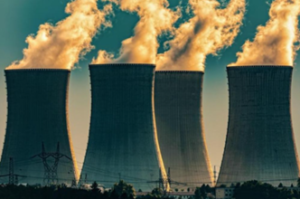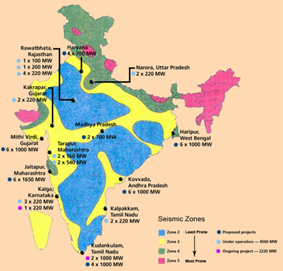Nuclear energy is clean but too risky to rely on.
Relevance
- GS Paper 2 and 3.
- Conservation, environmental pollution and degradation, environmental impact assessment.
- Bilateral, regional and global groupings and agreements involving India.
- Achievements of Indians in science & technology; indigenization of technology and developing new technology.
- Tags: #nuclear #france #india #cleanenergy #currentaffairs #upsc
Why in the News?
- India plans for modular nuclear reactors in partnership with France. India’s pursuit of clean energy solutions faces a critical juncture with the allure of nuclear power as a path to carbon neutrality.
- Recent plans for modular nuclear reactors in partnership with France offer a tantalizing glimpse into a fossil fuel-free future. However, the shadow of nuclear disasters and the formidable challenges of waste disposal loom large.
- Geopolitical entanglements and a history of limited contribution to the energy mix add further complexity. As we examine the potential of nuclear energy, it becomes clear that India must tread cautiously, weighing the benefits against the intricate web of risks and liabilities.
India and France’s Joint Vision
- India and France recently announced plans for the co-development of modular nuclear reactors, a promising avenue to achieve carbon neutrality by reducing reliance on fossil fuels.
- These reactors, known for their interchangeable parts and rapid assembly capabilities, could play a pivotal role in mitigating carbon emissions.
The Challenge of Renewable Energy
- India’s pursuit of carbon neutrality by 2070 necessitates a significant increase in non-fossil energy sources.
- While renewable capacity additions in wind, solar, and hydro energy projects are progressing, meeting the target of 500 gigawatts of electricity by 2030 demands accelerated efforts.
Nuclear Energy’s Global Complexities
Geopolitical Complexities and Historical Context
- The adoption of nuclear power in India has been fraught with geopolitical challenges.
- The 2005 nuclear deal with the United States, aimed at expanding India’s access to reactors and fuel supplies, did not yield the anticipated growth in the nuclear power sector. Geopolitical factors have contributed to this stagnation.
Low Contribution to India’s Energy Mix
- Nuclear power currently accounts for a mere 1.6% of India’s total installed generation capacity, with coal-fired plants continuing to dominate the energy landscape.
- This minimal share reflects the challenges nuclear energy faces in India.
Risk and Liability Concerns
The Burden of Liability
- India’s Civil Liability for Nuclear Damage Act of 2010 created a significant hurdle for the growth of the nuclear industry.
- The act imposed strict liability on reactor manufacturers and the supply chain, discouraging foreign suppliers from engaging in nuclear projects due to concerns about potential disasters.
The Grave Consequences of Nuclear Accidents
- The specter of a large-scale nuclear meltdown, akin to Chernobyl, poses an extreme but low-probability threat.
- The catastrophic impact of such an event, especially with an increased number of reactors, underscores the gravity of nuclear energy’s risks.
Challenges of Nuclear Waste Disposal
- The issue of nuclear waste disposal remains underdiscussed. While temporary storage in cooling ponds is a short-term solution, the long-term disposal of heavy nuclear waste in secure vaults deep underground or under the seabed is expensive and poses environmental risks.
The Need for Prudent Consideration
Nuclear Energy’s Role in Climate Goals
- While nuclear power holds promise in achieving climate goals, the unresolved issues of liability sharing and waste disposal necessitate cautious consideration.
Nuclear energy represents both a potential path to carbon neutrality and a source of significant risks and complexities. Before heavily relying on this energy source to meet climate objectives, addressing liability concerns and developing effective waste disposal solutions is imperative.
| Status of Nuclear Energy in India: Key Points
· Nuclear energy is a significant contributor to India’s electricity supply, accounting for approximately 2% of the country’s total electricity generation. · India boasts a substantial nuclear infrastructure, with over 22 nuclear reactors distributed across 7 power plants nationwide. These reactors collectively generate 6,780 MW of nuclear power. · Among the nuclear reactors in operation, 18 are Pressurised Heavy Water Reactors (PHWRs), while the remaining 4 are Light Water Reactors (LWRs). · In January 2021, India achieved a milestone with the connection of the Kakrapar Atomic Power Project (KAPP-3), the country’s first 700 MWe unit. This reactor represents the largest domestically developed variant of the PHWR. · The Indian government has fostered collaboration between the Nuclear Power Corporation of India Limited (NPCIL) and public sector undertakings (PSUs) to bolster the nation’s nuclear program. NPCIL has entered into joint ventures with entities such as the National Thermal Power Corporation Limited (NTPC) and the Indian Oil Corporation Limited (IOCL). · India is actively promoting the expansion of nuclear facilities to different regions of the country. An upcoming nuclear power plant in Gorakhpur, Haryana, is set to become operational in the near future, further diversifying the nation’s nuclear energy landscape. · India is also advancing in thorium-based nuclear technology, with plans for the “Bhavni” plant, which will be the country’s first to utilize Uranium-233. . Additionally, an experimental thorium plant named “Kamini” is already in operation in Kalpakkam, showcasing India’s commitment to exploring alternative nuclear energy sources. India’s three-stage nuclear program · PHWRs: Use natural uranium, produce electricity, and yield plutonium-239 (Pu-239). · FBRs: Utilize Pu-239 for increased energy output and fissile material production. · Thorium-Based Reactors: Focus on thorium as fuel for sustainable energy production. |
Sources: Livemint
Mains Question
“What are the key challenges and risks associated with India’s pursuit of nuclear energy as a means to achieve carbon neutrality, and how do these factors impact its energy landscape and climate goals?” 250words.





